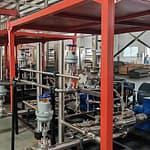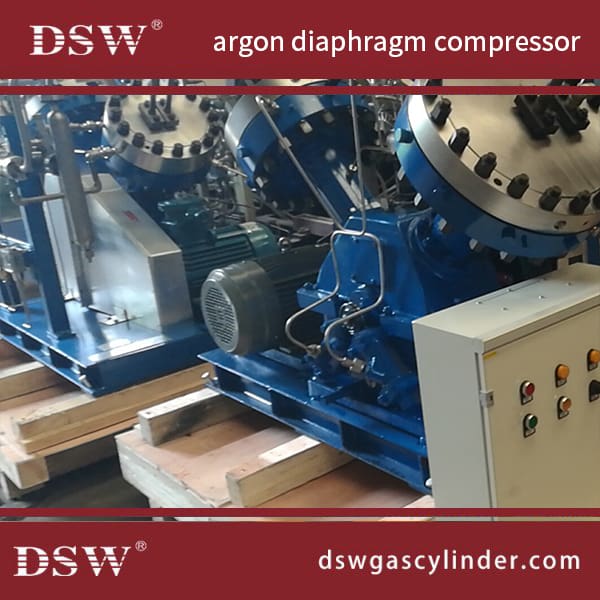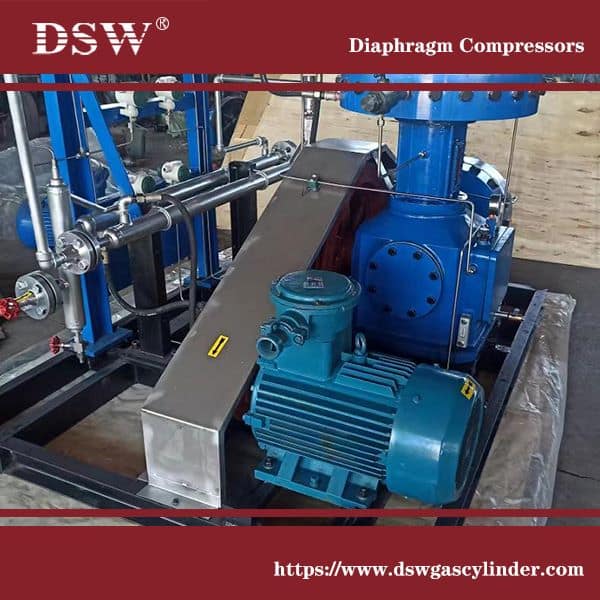Argon Diaphragm Compressor
DSW diaphragm compressors offer efficient lubricant- and technical wear-free compression of gases and mixtures of gases.
Due to their non-leakage operation, Diaphragm compressors make an excellent choice for the purest gases and explosive, toxic, and costly ones such as hydrogen sulfide, chlorine monosilane, or nitrogen trifluoride.
Diaphragm compressors ensure reliable compression of numerous gases such as hydrogen, helium, argon, ethylene fluorine, hydrogen sulfide, chlorine monosilane, or nitrogen trifluoride.
Membrane compressors are commonly used to fill storage vessels, feed continuous processes, or as gas-circulating compressors.
Diaphragm air compressors are exceptionally safe, reliable, and straightforward to maintain.
1: Argon Compressor
| Model: | GV-25/7-150 |
| Medium: | Ar, Argon |
| Type | V-style high-pressure diaphragm compressor with two cylinders and two-stage compressing |
| Discharge capacity: | 25Nm3/h |
| Discharge pressure: | 15MPa(G) |
| Intake condition: | 0.7MPa(G) |
| Rotate speed: | 400r/min |
| Lube type: | L-HM46 number of hydraulic oil (provide for oneself) |
2: Motor (supplied by requirement in contract)
| Model: | YX3-132M-4 |
| Type: | three-phase asynchronous motor |
| Rating Power: | 7.5kW |
| Rating rotate speed: | 1440r/min |
| Rating voltage: | 380V |
| Rating frequency: | 50Hz |
3: unit
| Size (length × width × height ): | 1600mm×900mm×1200mm |
| Unit net weight: | 1000kg |


What is the Diaphragm compressor?
Diaphragm Compressors, also called Membrane Compressors, are used for compressing gases with high purity and where leakage is not allowed.
Diaphragm Compressors are used for ultra-pure, toxic, poisonous, and flammable gases such as:
Anhydrous Hydrogen Chloride (HCI), Medical air/ Zero air, Argon, Nitric Oxide (NO), Carbon Monoxide (CO), Nitrogen, Ethylene, Oxygen, Fluorine, Radioactive gases, Heliox, SF6, Helium, Silane, Hydrogen, Xenon, Krypton, and other Special gases and gas mixtures.
Working of diaphragm compressor:
Diaphragm compressors consist of a hydraulic and an air pressure system. A metal diaphragm serves as an intermediary component between these systems and serves as protection between them; the air pressure system features three diaphragm plates sandwiched between two plate cavities for air input/output processes.
Hydraulic crankshaft motor control system uses piston movement at low pressure to regulate hydraulic fluid and to lower side parts of the diaphragm cavity swing, causing air process changes.
Some components of the hydraulic system can automatically fill pumps, hydraulic fluid valves, and air hydraulic valves with excess air while releasing any extra pressure that has built up within them.
To ensure the hydraulic system always satisfies pressure rotation, an automatic filling pump sends a fast angler into the hydraulic system after turning off the compressor. Should there be a compressive force on the main piston, the check valve protects from being compressed too tightly by the filler pump, creating an anti-hydraulic pump valve system and thus producing a pressure booster.
Our diaphragm compressors are preferred for high-purity and leak-tight gas compression applications.
DSW designs and manufactures basic- to fully instrumented, leak-free, and non-contaminating diaphragm gas compression systems according to customer specifications.










